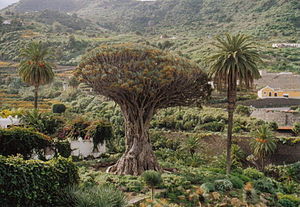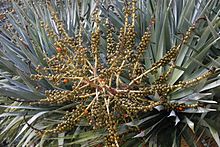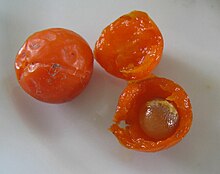Canarian dragon tree
| Canarian dragon tree | ||||||||||||
|---|---|---|---|---|---|---|---|---|---|---|---|---|

Canarian dragon tree ( Dracaena draco ) |
||||||||||||
| Systematics | ||||||||||||
|
||||||||||||
| Scientific name | ||||||||||||
| Dracaena draco | ||||||||||||
| ( L. ) L. |
The Canary Islands dragon tree ( Dracaena draco ) also dragon tree , dragon blood tree , is the best-known representative of the genus dragon trees ( Dracaena ), which belongs to the asparagus family (Asparagaceae). The specific epithet draco means 'dragon'.
When American or West Indian dragon tree, dragon's blood tree Pterocarpus officinalis called, is artverwandt the Sokotrische dragon tree, dragon's blood tree ( Dracaena cinnabari ). They also supply dragon blood resin .
description
The Canary Island dragon tree grows in a tree shape, but like all monocots (Liliopsida) has no real secondary growth , which would be a prerequisite for real tree growth. The plant reaches heights of growth of up to 20 meters. Young trees have a thick, gray trunk and can remain unbranched to a considerable size. The leaves stand in a forelock at the end of the branches. They are sword-shaped, light to dark green, red-brown at the base and are 50 to 60 cm long. They are stiff and long overhanging.
After eight to eleven years, the first flower panicle appears at the end . On its branches there are clustered greenish-white, six-fold flowers and later brown-orange berries. The flowering time is from July to August, with a flowering period starting about every 15 years . Below the inflorescence , branches of the thick branches emerge in a whirling arrangement, which finally lead to the characteristic canopy of older trees.
The number of chromosomes is 2n = 40.
Occurrence
The Canarian Dragon Tree is a North African- Macaronesian endemic . Its distribution area thus includes the Canary Islands , the Cape Verde Islands , Madeira and North Africa . Wild plants are rare and can only be found on inaccessible rocks and in ravines.
The plant is often planted in gardens.
One of the most famous dragon trees , the Drago Milenario , grows in Icod de los Vinos on Tenerife and is often referred to as the 1000 year old dragon tree. Taking into account the branching sequence and the intervals between the flowering periods, however, this specimen can only be assumed to be 400 years old. Other important specimens can be found in Pino Santo on Gran Canaria and Buraca on La Palma.
The species is the natural symbol of the island of Tenerife .
Systematics
There are two subspecies:
- Dracaena draco subsp. ajgal Benabid & Cuzin : It occurs in southwestern Morocco.
- Dracaena dracao subsp. draco : It occurs in the Canaries and Madeira and earlier also on the Cape Verde Islands.
Danger
Dracaena draco is in the endangered Red List species the IUCN as " Vulnerable (VU) ", d. H. endangered, classified.
Origin of name
The botanical genus name Dracaena comes from the Greek word drákaina and means female dragon . Different theories exist for the origin of the name.
On the one hand, the name is traced back to the fact that broken shoots usually sprout again and form two or more shoots in a branch, similar to a kite, which grows several new heads after chopping off a head. On the other hand, if the trunk is injured, an initially colorless juice emerges, which coagulates to a dark red resin in the air . This resin is also called "dragon's blood".
The Old Canarians , the natives of the Canary Islands, used it to heal broken bones and other injuries, but also to mummify their dead. In the Middle Ages, "dragon's blood" was as valuable as gold, as the Spanish conquerors also recognized the healing properties of the resinous substance. In the 19th century it was used as an additive to toothpaste as it was reputed to keep teeth and gums healthy. It was also used for lacquers and polishes, among other things in violin making and to make wood durable on buildings. The typical dark coloring of the wooden balconies and doors was originally based on this.
Usually the "dragon's blood" is tapped like rubber . However, this was often too laborious, so the dragon trees were often completely felled. This clear cutting for economic reasons is responsible for the fact that the dragon tree was threatened with extinction .
supporting documents
literature
- Adalbert Hohenester, Walter Welss: Excursion flora for the Canary Islands. With views of the whole of Macaronesia . Eugen Ulmer, Stuttgart (Hohenheim) 1993, ISBN 3-8001-3466-7 ( PDF file; 23.2 MB ).
- Miguel Ángel Cabrera Pérez: The native flora of the Canary Islands. Everest, León 1999, ISBN 84-241-3550-4 .
Individual evidence
- ^ Derwent Publications: Thesaurus of Agricultural Organisms. Vol. One: A-M , Chapman and Hall, 1990, ISBN 0-412-37290-8 , p. 399.
- ^ Meyers Konversations-Lexikon . Volume 5, 3rd edition, 1875, p. 620.
- ^ Tropicos .
- ↑ Ingrid Schönfelder, Peter Schönfelder : Kosmos Atlas Mediterranean and Canary Islands flora. Over 1600 species of plants . 2nd Edition. Franckh-Kosmos, Stuttgart 2002, ISBN 3-440-09361-1 .
- ↑ Ley 7/1991, de 30 de April, de símbolos de la naturaleza para las Islas Canarias .
- ↑ a b c Rafaël Govaerts (Ed.): Dracaena - data sheet at World Checklist of Selected Plant Families of the Board of Trustees of the Royal Botanic Gardens, Kew. Last accessed on September 16, 2016.
- ↑ Dracaena draco in the endangered Red List species the IUCN 2013. Posted by: Bañares, A. et al, 1998. Accessed on March 10, 2013 ...
Web links
- Günter Sinn, Hans-Peter Stoehrel, Rolf Canters: On the stability of the large dragon tree in Tenerife . In: Stadt + Grün - Das Gartenamt. Volume 46, Number 2, 1997 ( online ).

